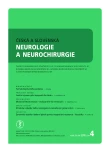Post-traumatic Hypopituitarism in Children and Adolescents
Authors:
J. Zapletalová 1; D. Aleksijević 1; V. Smolka 1; D. Krahulík 2; Z. Fryšák 3
Authors‘ workplace:
LF UP a FN Olomouc
Dětská klinika
1; LF UP a FN Olomouc
Neurochirurgická klinika
2; LF UP a FN Olomouc
III. interní klinika
3
Published in:
Cesk Slov Neurol N 2010; 73/106(4): 398-401
Category:
Review Article
Overview
Hypothalamic-pituitary axis failure significantly affects morbidity in subjects after moderate to severe brain injury. Post-mortem histopathological studies have demonstrated the vulnerability of the hypothalamus and pituitary to external injury. Endocrine changes in the first hours and days after an accident are usually transient and comparable to those observed at other critical stages (known as “sick syndrome”). Frequent and expected complications usually include temporary disturbances of water metabolism. These changes may take the form of diabetes insipidus and can be identified as inappropriate antidiuretic hormone secretion syndrome. Both of these are consequences of transient neuropituitary dysfunction. Hormonal changes that occur months or even years after an accident were once considered exceptional. This view has changed over the past decade in view of the results of several studies in adults that give the prevalence of post-traumatic hypopituitarism at between 23 and 69%. Substantially less is known about the prevalence and implications for neuro-endocrine dysfunction in the pediatric population compared to that in adults. Untreated hormonal disturbances may have significant and permanent impacts upon a child’s mental and physical development. This article provides basic information about trauma-induced hormonal dysfunction in children and adults.
Key words:
brain injury – post-traumatic hypopituitarism
Sources
1. Masson F, Salmi LR, Maurette P, Dartigues JF, Vecsay J, Garros B et al. Characteristics of head trauma in children: epidemiology and 5-years follow up. Arch Pediatr 1996; 3(7): 651–660.
2. Schneier AJ, Schields BJ, Hostetler SG, Xiang H, Smith GA. Incidence of pediatric traumatic brain injury and associated hospital resource utilization in the United States. Pediatrics 2006; 118(2): 483–492.
3. Brichtová E. Analýza souboru pacientů s kraniocerebrálním poraněním léčených na Pracovišti dětské medicíny FN Brno v období let 2000–2007. Cesk Slov Neurol N 2008; 71/104(4): 466–471.
4. Kahler O. Die dauernde Polyurie als cerebrales Herdsymptom. Z Heilk 1886; 7: 105–220.
5. Cyran E. Hypophysisenschadigung durch Schadel-basis fracture. Dtsch Med Wochenschr 1918; 44: 1261–1270.
6. Benvenga S, Campenni A, Ruggeri RM, Trimarchi F. Clinical review 113: hypopituitarism secondary to head trauma. J Clin Endocrinol Metab 2000; 85(4): 1353–1360.
7. Urban RJ, Harris P, Massel B. Anterior hypopituitarism following traumatic brain injury. Brain Inj 2005; 19(5): 349–358.
8. Ceballos R. Pituitary changes in head trauma (analysis of 102 consecutive cases of head injury). Ala J Med Sci 1966; 3(2): 185–198.
9. Crompton MR. Hypothalamic lesions following closed head injury. Brain 1971; 94(1): 165–172.
10. Harper CG, Doyle D, Adams JH, Graham DI. Analysis of abnormalities in pituitary gland in non-missile head injury: study of 100 consecutives cases. J Clin Pathol 1986; 39(7): 769–773.
11. Gaetz M. The neurophysiology of brain injury. Clin Neurophysiol 2004; 115(1): 4–18.
12. Robertson CL, Soane L, Siegel ZT, Fiskum G. The potential role of mitochondria in pediatric traumatic brain injury. Dev Neurosci 2006; 28(4–5): 432–446.
13. Agha A, Rogers B, Myllote D et al. Neuroendocrine dysfunction in the acute phase of traumatic brain injury. Clin Endocrinol 2004; 60(5): 584–591.
14. Agha A, Sherlock M, Phillips J, Tormey W, Thompson CJ. The natural history of posttraumatic neurohypophysial dysfunction. Eur J Endocrinol 2005; 152(3): 371–377.
15. Albanese A, Hidmarsh P, Stanhope R. Management of hyponatremia in patients with acute cerebral insult. Arch Dis Child 2001; 85(3): 246–251.
16. Einaudi S, Bondone C. The effects of head trauma on hypothalamic-pituitary function in children and adolescents. Curr Opin Pediatr 2007; 19(4): 465–470.
17. Palmer BF. Hyponatremia in patients with central nervous system disease: SIADH versus CSW. Trends Endocrinol Metab 2003; 14 (4): 182–187.
18. Jiménez R, Casado-Flores J, Nieto M, García-Teresa MA. Cerebral salt wasting syndrome in children with acute central nervous injury. Pediatr Neurol 2006; 35(4): 261–263.
19. Woolf PD. Hormonal response to trauma. Crit Care Med 1992; 20(2): 216–226.
20. Sockalosky JJ, Kriel RL, Krach LE, Sheehan M. Precocious puberty after traumatic brain injury. J Pediat 1987; 110(3): 373–377.
21. Goldman M, Shahar E, Sack J, Meyerovitch J. Assessment of endocrine function in children following severe head trauma. Pediatr Neurol 1997; 17(4): 339–343.
22. Einaudi S, Matarazzo P, Peretta P, Grossetti P, Giordano F, Altare F et al. Hypothalamo-hypophysial dysfunction after traumatic brain injury in children and adolescents: a preliminary retrospective and prospective study. J Pediatr Endocrinol Metab 2006; 19(5): 691–703.
23. Poomthavorn P, Maixner W, Zacharin M. Pituitary function in paediatric survivors of severe traumatic brain injury. Arch Dis Child 2008; 93(2): 133–137.
24. McDonald A, Lindell M, Dunger DB, Acerini CL. Traumatic brain injury is a rarely reported cause of growth hormone deficiency. J Pediatr 2008; 152(4): 590–593.
Labels
Paediatric neurology Neurosurgery NeurologyArticle was published in
Czech and Slovak Neurology and Neurosurgery

2010 Issue 4
Most read in this issue
- Dynamic Magnetic Resonance Imaging of a Lumbar Spine – a Case Report
- Pharmacological Approaches to the Treatment of Epilepsy
- Treatment of Juxtafacet Cyst of the Lumbar Spine by Dynamic Interspinous Stabilization – a Case Report
- Functional Significance of a Temporal Lobe
